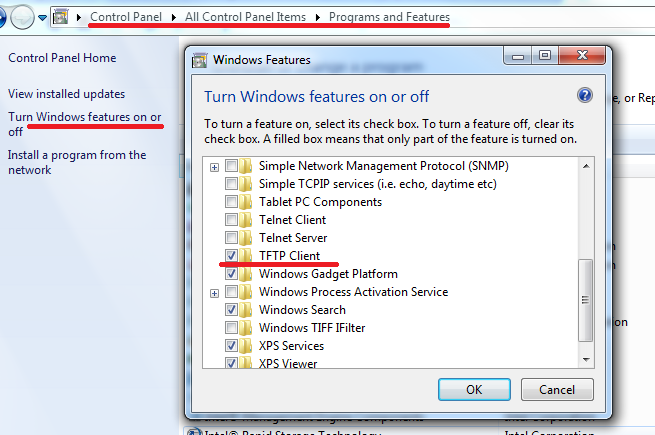
#Arch tftp client Pc#
So my question is, has anyone ever done this successfully before that can offer some advice or point me in the right direction? I would really appreciate it.Įdit: forgot to add, the main goal is to have the PC boot into the diskless node whenever it's booted up via Wake on Lan and have it boot up into the hard drive (Windows) whenever you press the power button. Here is a pic of the client booting up, it seems like the DHCP server is working correctly and the server is assigning an IP address to the client so to my knowledge, I don't think that's the problem, but then again I might be wrong. The TFTP Wiki page doesn't really offer much help on the configuration side, after hours of googling and looking on the forums, trying different things I have gotten nowhere and since I'm learning and researching as I go along, I'm basically stuck. I've been trying to research what is the proper configuration, but have failed miserably. I've been following Diskless System Wiki page for the configuration using NFS and tftp-hpa (I have also found this guide that is basically the same thing as the wiki, but it shows some DHCP and TFTP configurations) and everything seems to have gone well, I've succesfully installed Arch on the "/srv/arch" directory (at least it seems that way) of the master node and have followed everything the guide has said but, I'm having some trouble getting the TFTP server to send the bootloader, kernel, etc to the client. Now, I've been trying to set up some diskless nodes and I'm having a bit of trouble, I was wondering if anyone could help me out please. Clonezilla, Archlinux etc.) should be stored.Hi, I'm sort of new to Arch, been a lurker for some time and I've been working at school with Arch for some months now, managed to build a working Beowulf Cluster for a school project using Arch so that was pretty cool. Server There are several TFTP server implementations, some of which are listed below. It is generally used as a part of PXE booting or for updating configuration and firmware on devices which have limited memory such as routers, IP phones and printers. Afterwards a directory is created in the root folder, where the The Trivial File Transfer Protocol (TFTP) provides a minimalistic means for transferring files. The Syslinuxįolder becomes the root folder.
#Arch tftp client iso#
The ISO file is to be mounted, and then the necessary files are copied from it. In this example Syslinux is used directly from Archlinux ISO.Ĥ images are configured (2 times Archlinux, Clonezilla). In addition to the conventional DHCP exchange, supplementary information is sent from the Proxy DHCP Since the DHCP server is not always under the control of the developer, the Proxy DHCP solution is needed. The remote host may be specified on the command line, in which case tftp uses host as the default host for future transfers (see the connect command below. var/lib/tftpboot/uefi cp mylocaldirectory/boot/efi/EFI/redhat/ARCH.efi /var/lib/tftpboot/uefi/.
#Arch tftp client download#
T->-C: Bootstrap Program Download Port 69 Proxy DHCP tftp is a client for the Trivial file Transfer Protocol, which can be used to transfer files to and from remote machines, including some very minimalistic, usually embedded, systems. Configuring a TFTP server for BIOS-based clients. Reply Port 67 oder 4011Ĭ->+T: Bootstrap Program Download Request Port 69 A possible bootloader program is PXELinux.Ĭ->+S: Boot Service Discover Port 67 oder 4011 mkinitcpio, a program to generate initramfs on Arch Linux and related. Lines 68: Provide the TFTP host directory and a boot file name. and handle each specific case you encounter. After receiving a DHCP acknowledgment, the client initiates a TFTP read. Afterwards the client can load the initial Network Bootstrap Program (NBP) and execute In Linux systems, initrd (initial ramdisk) is a scheme for loading a temporary root file. Every member of the program had a talent to share either on the stage or. Information like the TFTP server and bootloader file address.
#Arch tftp client code#
The PXE code will then first configure the interface via DHCP and gets the extended

The client to be booted must have a PXE-enabled network card. NFS server / HTTP server (nfs-server, nginx, darkhttpd).This can be used for example emergency systems orĪn Installation media without a USB stick.


(PXE) is a technique that enables the distribution of arbitrary executable code or user data over the network. Write-up to Simple Netcat Socat Reverse Shells.Write-up to the Metasploit Reverse Shell.


 0 kommentar(er)
0 kommentar(er)
